You’ve built a beautiful website for your personal training business. It’s got pictures, videos, and even some glowing testimonials from your ecstatic clients, BUT there’s just one problem:
Barely anyone is visiting your site!
And those who do find you online certainly aren’t buying anything!
Was all the time and money you invested in your business’s website a waste?
Not a chance!
It's just time to learn how to start a fitness blog that will pull in traffic, leads, and sales!

Your website has the potential to be a sales-generating machine, but there are a few tweaks you need to make in order to unleash its full money-earning power.
Interested?
(of course you are…who doesn’t like earning more money?)
Before we begin, there are some important concepts you should understand about website traffic generation and online marketing…
Website Traffic Generation 101
Every day 3.5 billon searches are performed using Google. People search for everything nowadays: They look for nearby restaurants, they compare products, they look up direction, and they definitely turn to Google when they want to get in better shape.
For example, each month 201,000 people type “how to lose belly fat” into Google.

Do you think that some of those people might be interested in the fitness products or services you have to offer?
Do you think you could help solve their problem?
That’s why website traffic that comes from search engines is so important. If someone is looking online for weight-loss solutions, they are pre-screened as a potential customer for any products or services related to weight-loss.
Search engines are the holy grail of traffic sources because they send targeted traffic
Those searchers are telling Google, “I need help losing weight” and it’s Google’s job to present them with the best options available online.
If only Google would lead all of those people straight to your website. That sure would make your life a whole lot easier!
Unfortunately, there are thousands (or perhaps millions) of other personal trainers who are thinking the same thing. They all want website traffic from Google. They want those people who are searching for weight-loss to show up on their digital doorstep.
It’s a fierce competition! (As you can see from the “belly fat” search results…over 9 million websites are offering advice on that topic!)
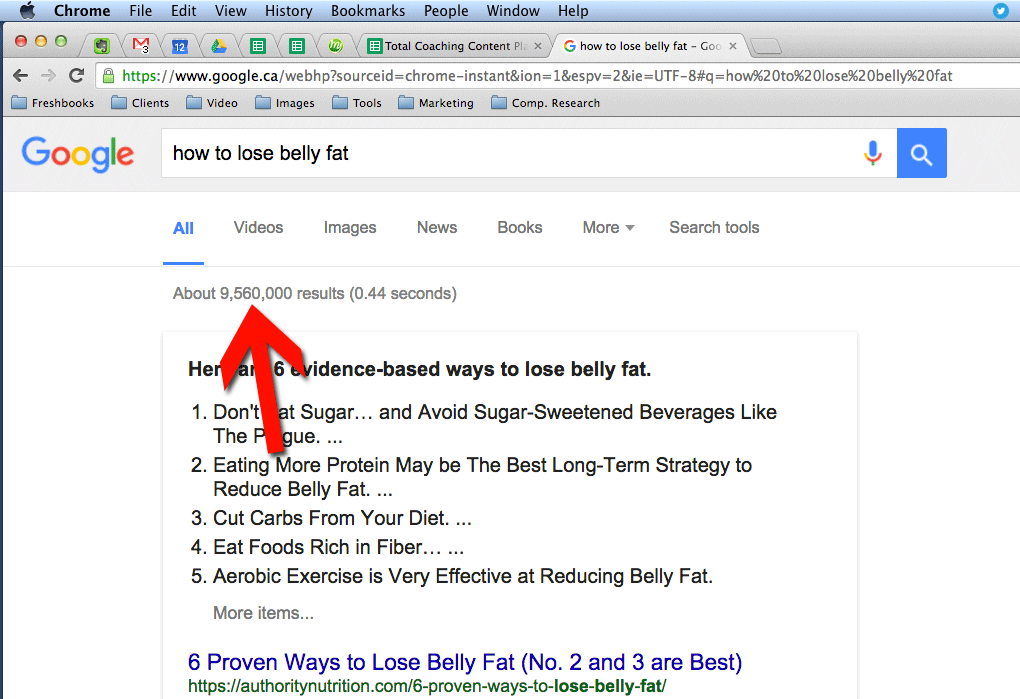
How can you convince Google to show off your website instead of the website owned by one of your competitors?
You need to start a fitness blog.
“A blog? How will that bring me more website visitors?” (great question!)
Remember that Google’s job is to serve up the BEST answers to any question a person types into the Google search bar. If your website is all about you and the programs you offer for sale, it’s very unlikely that Google will deem your site to be one of the best resources available online.
Without blog content on your fitness website, Google has little reason to send you visitors
Google will skip your site because there are better informational sources found elsewhere.
This is where a blog comes in so handy…
A blog provides a place on your website to prove to Google that you really want to help others...
You are more than just an online storefront. You are passionate about fitness and are ready, willing, and able to share your passion with those who need it most.
Once Google identifies your website as a credible information source, there is a good chance you’ll start seeing some traffic trickle in.
Then, if you engage those new website visitors and provide them with the answers they’re looking for, Google will take notice. More traffic will be headed your way and soon your fitness website will be attracting hundreds or even thousands of visitors per day!
Pretty exciting, huh?
But, in order to capture this flow of free traffic, your website needs a blog, one that’s optimized to attract search engine traffic.
If you’ve never blogged before, don’t worry. The following 7 steps will help get you started in no time:
How to Create a Revenue-Generating Fitness Blog
As you read through the steps outlined below, keep in mind that maintaining a blog on your website can become a time-consuming venture. However, the overarching purpose of starting your fitness blog is to drive traffic to your website and eventually convert those visitors into paying customers.
Think of the following steps as a crucial part of your marketing plan. Be diligent and consistent and these marketing efforts can produce an excellent return on your initial investment.
Step #1. Identify Your Blog Niche
Many fitness bloggers make the mistake of trying to be everything to everyone. One day they write about exercise for the elderly, another they’re sharing recipes for parents on a budget.
You want to be seen as an authority blogger, a true expert in your space, and the best (and quickest) way to do that is by zeroing in on a very specific niche audience.
For example, your blog might target competitive rowers, or new moms recovering from C-section births, or fitness for the blind. The more targeted your blog, the easier it will be to be seen as an authority and to attract a loyal audience.
Find the niche you have passion for, educate and become an expert.#startup #entrepreneur pic.twitter.com/cGv2G8MPUN
— Affordable Website (@4dabledotcom) March 16, 2016
Choosing a niche to hone in on doesn’t mean that you will only write on one specific topic, but it does provide a theme for your blog and will help keep you focused. Your content will appeal directly to your ideal consumer and will therefore become a great source of information that they will return to again and again.
As you begin brainstorming ideas for your blog niche, ask yourself the following questions:
- Who do I enjoy working with most?
- Do I have the necessary experience to help people within this niche?
- Can I imagine creating content for this niche long-term? (i.e. can you imagine yourself blogging for this audience for the next 6 months? Or even the next 5 years?)
Once you’ve chosen your niche, it can be very helpful to create what’s known as an “Avatar” for you blog. This is a persona who embodies your ideal target consumer.
Imagine that you’ve decided to blog about rowing since you have experience as a competitive rower and would like to work with others who are training for competition.
- How old is your ideal consumer?
- Is this client a male or female?
- Where do they live?
- How much money do they make?
- Where do they work?
- Are they married?
- Do they have kids?
- What do they do for fun? (besides rowing of course!)
- What excited them in life?
- What are their goals and aspirations?
- What fears so they have?
- Etc.
Creating a client avatar will keep you focused on meeting their needs
Describe your avatar in as much detail as possible and then give him or her a name.
Don’t skip this step!
Naming your avatar allows you to know him or her “personally” and allows you to ask, “Would Kevin be interested in this blog post?” (assuming you named your avatar Kevin).
Here's a quick guide to help you get clear on your ideal client avatar. https://t.co/cz6l8OCKQZ pic.twitter.com/asRIEM6szi
— Lisa Jackson (@LisaJacksonSYL) March 22, 2016
Now that you know exactly WHO your blog is intended to serve, it’s time to determine HOW you can meet their needs.
Step #2. Identify the Most Desirable Blog Content
When it comes to driving traffic to your blog, quality is so much more important that quantity.
For example, let’s say you’re a personal trainer who primarily serves women post-pregnancy. You could write an article called “How to Increase Your Bench Press by 50% in 3 Weeks” – this article might even get a ton of views – but is that the traffic you really want?
Nope.
Your content needs to be perfectly aligned with your target client; otherwise you will attract the wrong traffic and will likely make very few (if any) sales.
How do you know what your target clients want to learn about?
1. Ask them. You likely know at least a handful of people who are in your target demographic. Use them as your test subjects by sending out a market research survey for them to complete.
I recommend using the free version of SurveyMonkey.com. You can create all different types of questions, such as multiple choice, ranking, true/false, and open-ended ones.

You can send the surveys via email or post via social media.
PRO TIP: FACEBOOK RESEARCH
When posting your survey link on Facebook, ask people to tag others who might be interested in this topic. This is a very easy way to increase your reach and connect with others you may not personally know.
2. Join Facebook groups. There are Facebook groups on pretty much any topic you could imagine. Since these groups bring together people of a common interest or who are going through a common life stage, Facebook groups are a perfect place to gather content ideas for your blog.
To really know your clients, you need to BE where your clients spend time
As an example, imagine you are a running coach and you are looking for clients who would be interested in marathon training. You can search for groups with the word “running” in the name and you’ll find ones like this:

Do you think a “Yoga For Runners” group might be a place to eavesdrop on some discussions about running? You better believe it!
Take note of common questions and conversation topics that are happening in these Facebook groups. These are blog content goldmines!
3. Search Twitter hash tags. One of the beauties of Twitter is the fact that hash tags make it so simple to search out conversation topics.
Log into your Twitter account and then use the search bar to find a topic that would be relevant to your ideal clients. For example, if you are training competitive athletes who would be interested in jumping higher, try using “plyometrics” as your search term.

Now you can scroll through tweets that have used “plyometrics” as a hash tag. Which posts got re-tweeted or liked the most? Were there any comments or questions about any of these Tweets?
You’re looking to see where interest lies. The more interest, the more likely you’ve just uncovered a great blog topic that will attract visitors to your site.
4. Read Amazon reviews. Amazon doesn’t seem like a logical place to do content research for your blog, but it is ideal! Here’s why…
Visit Amazon and use the search box to look for a product that your ideal clients would be interested in. Let’s go back to our example of training new moms – I typed in “mom fitness books” and look what I got:
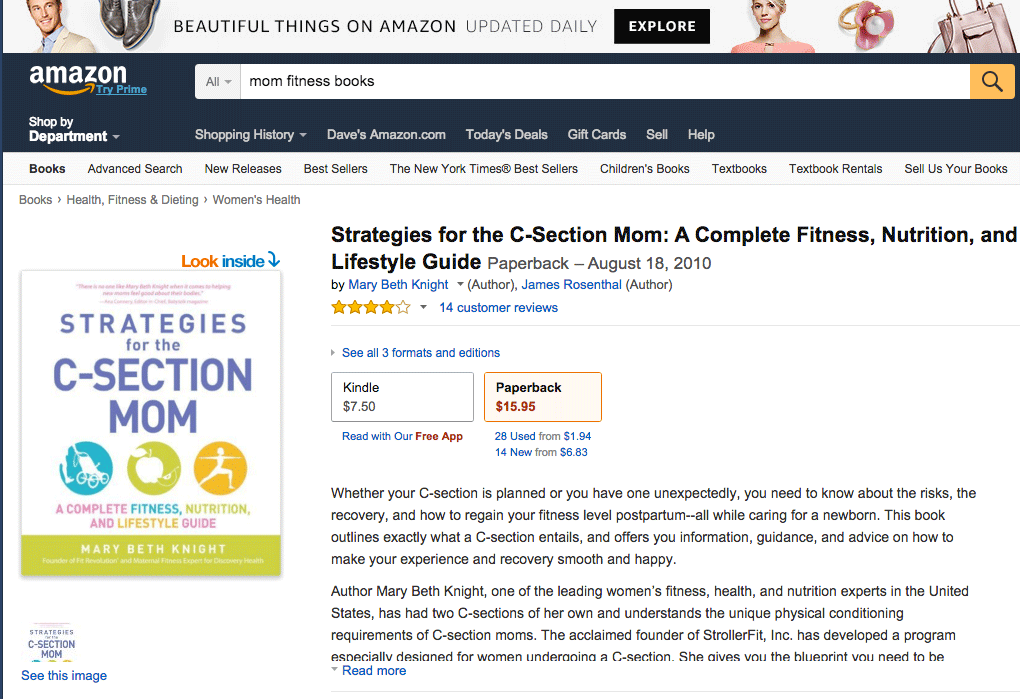
Will a new mom (especially one who’s had a C-section!) be interested in this book? Uh, yeah! But that’s not the fun part…
This book has 14 reviews (many books will have a LOT more!). You can skim through those reviews to look for themes. What are these moms talking about most frequently? What did they really like about the book? What was missing from the book that has them asking questions?
Again, all of these content cues are perfect topics for your blog. Write down every idea you see!
Step #3. Laser Target Your Content Using Keyword Research
Now that you have a long list of highly-targeted content ideas that you know your ideal clients will love, it’s time fine-tune your ideas for maximum results.
Again, let’s say you are targeting new moms as your ideal clientele and you’ve identified that they are very interested in toning their stomach muscles. But what exactly do these prospective clients search for when they look for help?
Are you blogging? Do keyword research. Here's how. https://t.co/q8gqAUNMCN pic.twitter.com/lhSc59Nvpe
— BlogMutt (@blogmutt) March 11, 2016
Maybe they typed, “how to tone my tummy after giving birth” into the Google search bar?
Or maybe it’s, “best ab workouts for new moms”?
Perhaps they use, “mom 6-pack workout program”?
What specifically are they looking for?
This might seem like a trivial question to ask, but it’s an extremely important one. You see, if you create an amazing blog post that is all about “mom 6-pack workouts,” but new moms are really looking for “tummy toning post-pregnancy,” there is a slim chance your content is going to be found in Google.
Yes, your content is on the right topic, but the words you’re using aren’t the same ones your ideal customers are using. You need to fix this problem. Here’s how:
1. Go to Google and search for “Google Keyword Planner” – click on the first result that comes up. This is a tool that shows you what people are searching for AND how many other websites or blogs are serving up this exact content.
In other words, this tool helps you find opportunities to create new content that people want, but that they can’t find elsewhere online.
2. Choose to search for new keywords as shown in the image below:
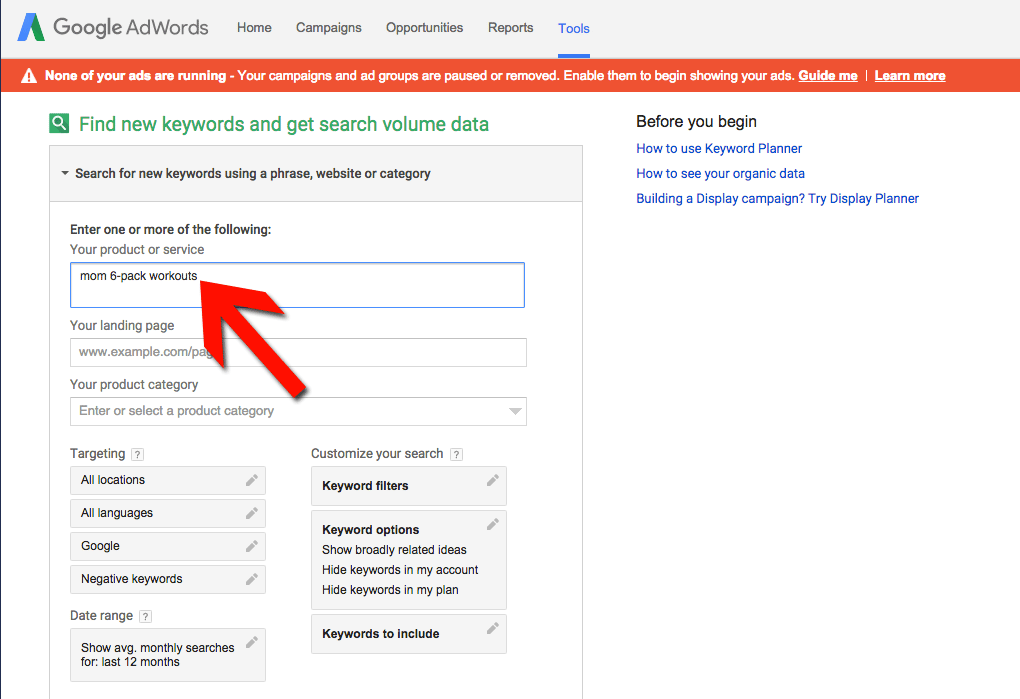
3. Type in a keyword that you think your target clients might be searching for. In this case I’m using “mom 6-pack workouts” because I noticed a lot of new moms talked about toning their abs after giving birth. After entering your keyword phrase, click “Get Ideas” near the bottom of the page.
4. Click on “keyword ideas” as seen in the image below:

5. Analyze your results and choose the winners. The Google Keyword Planner will list keyword ideas that are very similar to the one you suggested. They will be listed in order of relevance, and will display some very helpful data:
- Average Monthly Searches - This shows how many times someone typed that exact phrase into Google each month. In general, the more searches, the better.
- Competition – This indicates how many websites are already covering this exact topic. A “low” competition rating suggests that a topic isn’t over-saturated.
- Suggested Bid – This shows what people are paying to have their website show up in the top few spots when someone searches for this exact term. A higher suggested bid indicates that more website owners are fighting for the coveted top spots.
So what should you be looking for? Ideally you will find a keyword that…
- Is very relevant to your content topic
- Has a relatively high search volume (I look for 1,000+ searches per month)
- Has a “low” competition rating
- Suggests low advertising bids (this really varies depending on your topic, but I’d recommend staying away from keywords with suggested bids of $5 or more)
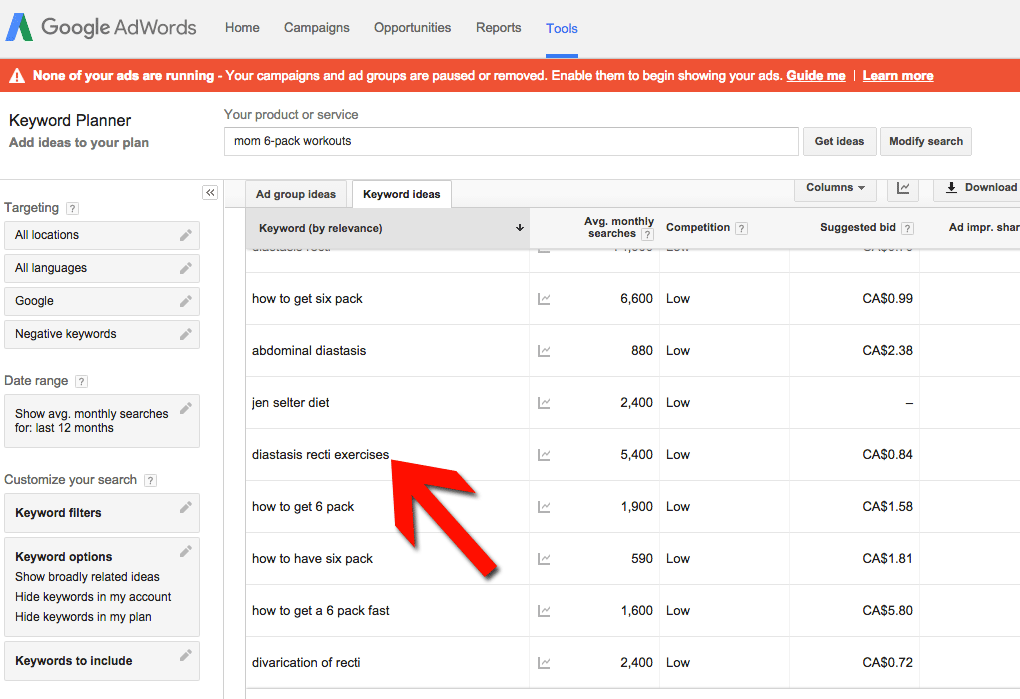
Take a look at the example above. The search term “diastasis recti exercises” might be a perfect choice. Diastasis recti is a condition where the abdominal muscles have separated, most often caused by the birthing process. Exercises that will help remedy this condition are certainly going to be of interest to a target market of new moms.
Notice also that 5,400 people search for this term each month! There is potential to drive a LOT of traffic to your website using this keyword.
Even seemingly obscure search terms can drive LOTS of traffic to your blog each month!
The competition is “low” and the suggested bid price is only $0.84. These two factors suggest that this keyword isn’t one that other websites are fighting over. This could be an excellent opportunity for you to seize!
Jot down any keywords other opportunistic keywords – You will use these to strategically build your next piece of blog content.
PRO TIP: USE KEYWORD TOOLS
The Google Keyword Planner is a free tool, but there are other paid-for tools that provide even more data and make this research process more time efficient.
I recommend Market Samurai because of the extremely valuable keyword research it provides at a very low price. It will help you uncover hundreds of keywords that you won’t easily find using the Google Keyword Planner, plus it will help you clearly identify which of these are going to provide you with the best results.
The image below shows a report compiled in Market Samurai that explains how good your keyword really is. Green boxes indicate that the top Google results for this keyword are weak, whereas red boxes indicate strength.
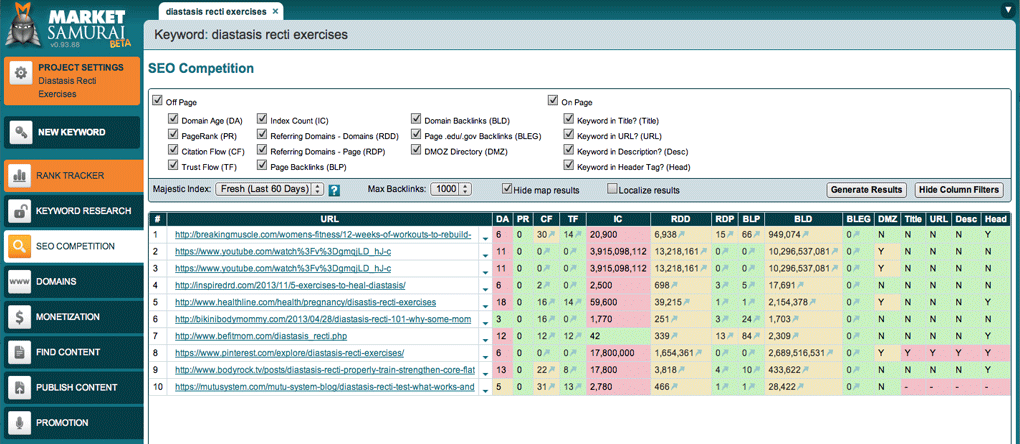
In this case, “diastasis recti exercises” shows a lot of green, which means that you could likely create a piece of content that’s better than what currently exists online. This is good news!
Click here to learn more about how you can use Market Samurai to increase traffic to your blog.
Step #4. Build Content Using Keyword Optimization (don’t skip this step!)
You might be wondering why you went to all that trouble of finding an ideal keyword that will resonate with your target market. Here’s why…
You are going to create the BEST piece of content to be found anywhere online that addresses that specific topic.
In other words, YOU are going to become the authority when it comes to teaching others about your chosen keyword!
7 Step Content Creation Strategy for Epic Content Marketing https://t.co/75VcjaBoxs via @jeffbullas #ICCAWorld pic.twitter.com/8rQBdRXKl8
— Mathijs Vleeming (@MathijsV) March 17, 2016
In the next step of this guide we will look at what type of content you should create. For now, we’re going to look at the technical aspects of setting up an optimized blog post.
Again, we’ll use our example keyword, “diastasis recti exercises.” It’s your job to clearly tell Google that your post is all about this topic. Here are a few simple steps to doing just that:
- Put your exact keyword in your blog post title – Name your blog post something like “Diastasis Recti Exercises: Safely Strengthen Your Core” so that Google (and potential readers) know exactly what topic you will be covering in your content.
The following post targets the keyword, “Best Healthy Food Blogs” and therefore prominently places this keyword in the post title.
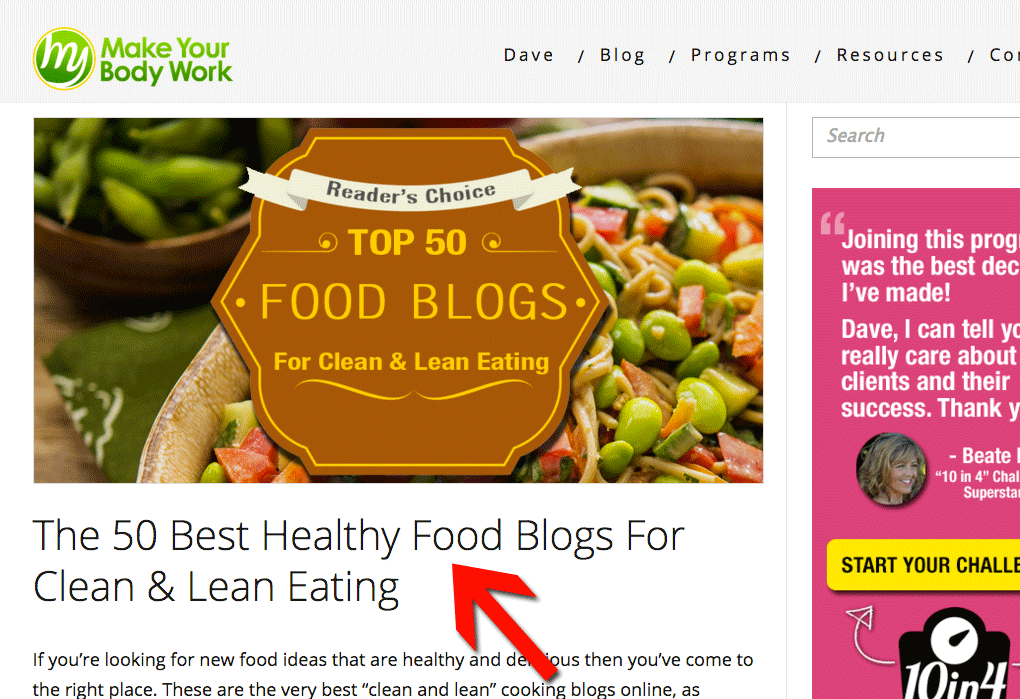
- Use the exact keyword in the first paragraph – Again, you want to quickly establish that people are in the right spot if they are looking for information about “diastasis recti exercises.”
- Put your keyword in at least one subheading – When your keyword appears in a subheading (i.e. one that uses H2 or H3 font), this again indicates to Google that your content is squarely focused on this topic.
- Use your keyword in the body text – Without overdoing it, Google wants to see that your keyword is used throughout the body of your content. You can also use variations of your exact keyword such as, “exercises for diastasis recti” so that it doesn’t appear as if you’re simply stuffing your content full of the same keyword over and over.
- Add your keyword as alt text – When you insert an image into your post you can add what’s known as alt text. Since Google can’t read images, it uses this “alternative text” to learn what the pictures are about. Label a picture using your keyword to give Google another indication that your post teaches on that subject.
Placing your keyword in the right places within your content is essential if you want Google to take notice. Remember, Google is a robot, it’s not a person, therefore you have to give it as many cues as possible that say, “Hey, my content is all about _______! Show this to people who search for this topic!”
Step #5. Create Epic Content That Gets Noticed
Before you begin creating anything, go to Google and type your keyword into the search box. Using our “diastasis recti exercises” example, we get the top Google results and can begin to look at what makes them deserve to be ranked so highly:
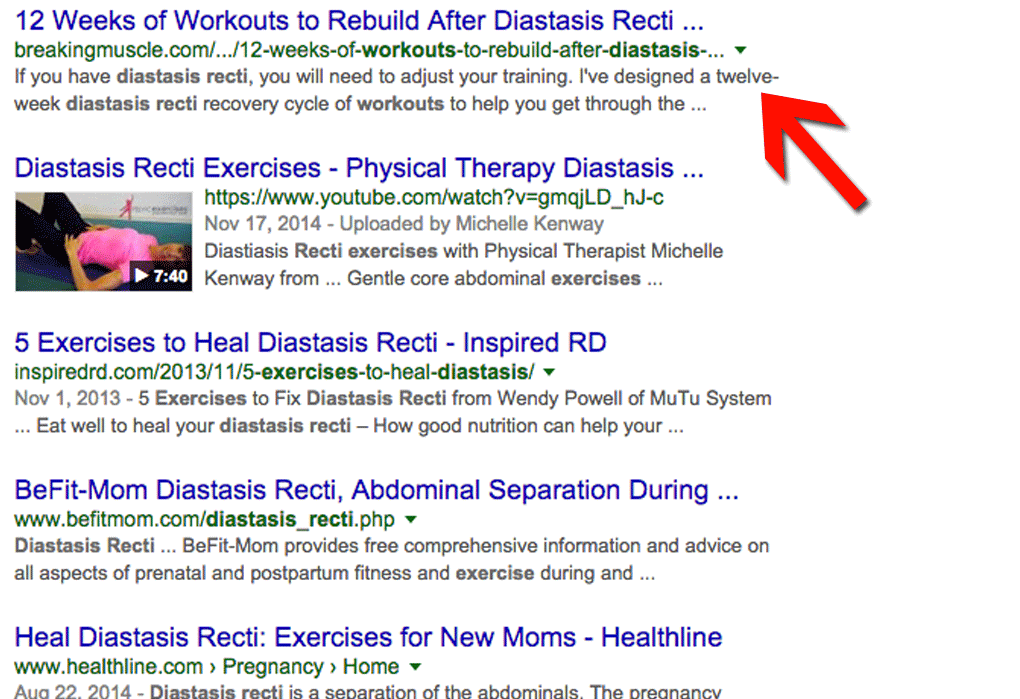
It’s important to remember the job of Google. It’s a search engine designed to retrieve the BEST resources on the web for any given search terms. So, even if you optimize your content using the tips in Step #4 of this guide, the quality of your content will ultimately determine whether or not your page gets ranked on the coveted first page of Google.
Your content has to be worthy of a first-page ranking in Google in order to get and stay there!
Looking at the top few results for your given keyword, ask yourself these two very important questions:
1. Why did this piece of content deserve to be ranked on the first page of Google? Did include a helpful video, an awesome infographic, a unique guide, interesting research results, or something else that sets it apart?
2. Can I create a piece of content that deserves to outrank this existing piece? Again, Google intends to show only the best content out there. Can you create a piece of content that really is better than what already exists?
In our example, the top spot in Google is occupied by a site offering a 12-week training program for moms with diastasis recti. That’s a pretty useful resource! Is there a way to build on that valuable content to make yours an even better choice?
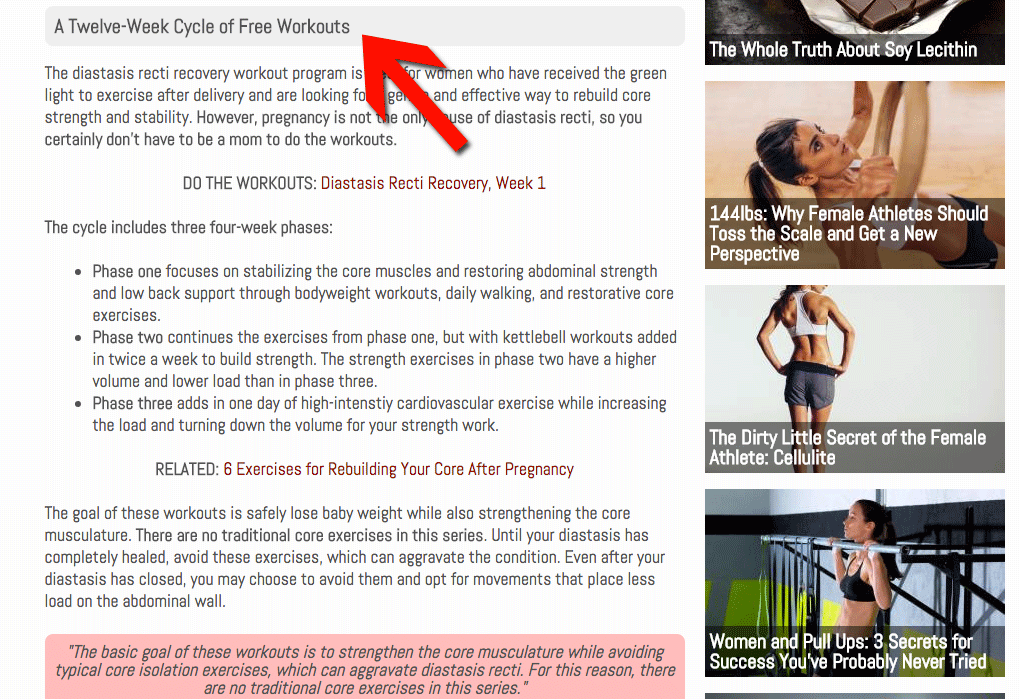
Keep in mind that there is tremendous value of being ranked on the first page of Google, not just the first spot. Ranking, say, in the third spot for a good keyword can still provide hundreds or even thousands of new visitors to your site each month.
However, that first spot certainly does get the most traffic, so it’s always good to aim high. Can you create something better than that top piece of content?
Step #6. Prove Your Authority with Off-Page SEO
Optimizing your page and making sure your content truly is epic go together to form what’s known as “on-page SEO.” These are the steps you can take on your page to prove to Google that your web content is worthy of getting loads of traffic sent to it.
However, that’s not the entire story…
“Off-page SEO” are quality indicators that come from sources outside your own website. While there are dozens (or even hundreds) of factors that influence how well your content ranks, other sites linking to your content are among the most important.
These backlinks show Google that your piece of content is so valuable that other website owners chose to link to you. They think you are just THAT great!
There are plenty of strategies for building up your backlinks that you can experiment with, but keep in mind several things:
1. Amazing content deserves more backlinks. Nobody will choose to link to your content (or even share it on social media) if it doesn’t provide true value. Again, make sure your content is epic (see Step #5 in this guide) before you begin looking for backlinks.
2. Backlinks rarely just happen. Even if your content is leaps and bounds better than what’s currently online, it’s unlikely that people will just stumble across your site and decide to link to you. You need to promote your content so that people see it, read it, and love it!
In the example below, Betty Rocker uses Facebook ads to get her content in front of eyeballs. Once it’s been seen (and proven worthy), there is likelihood that people will share it and even link to it.
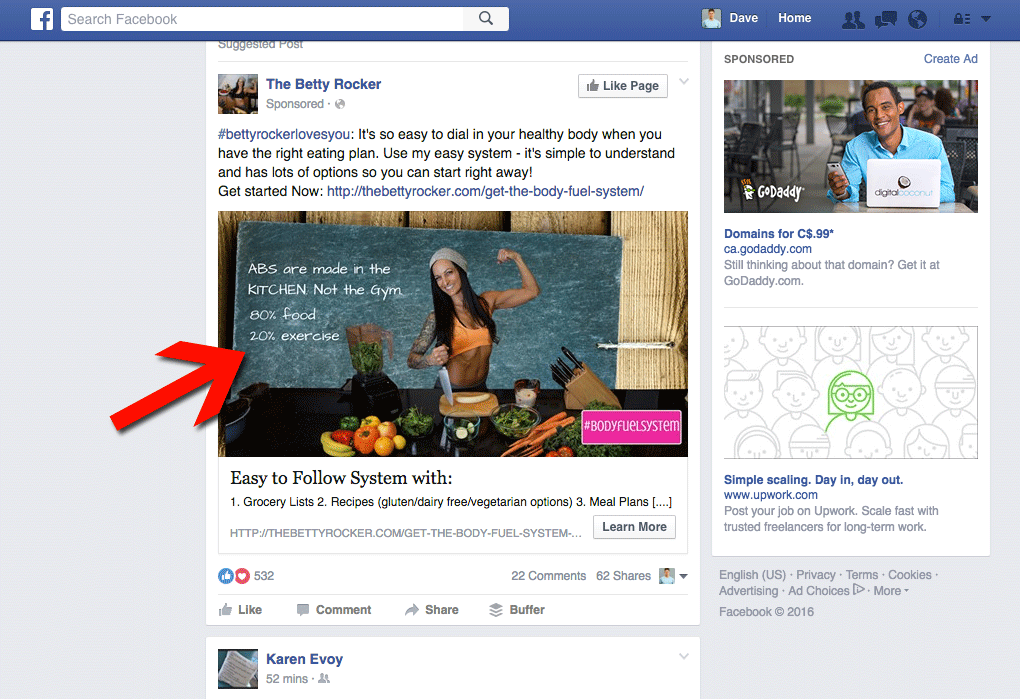
3. It’s not about quantity. If you followed the tips in Step #3 of this guide to select a really great keyword, chances are you won’t need that many backlinks to begin ranking well in Google.
It can seem like such an uphill battle since other content may have existed for months or years, but it often only takes a few strategic backlinks to propel new content to the top of Google’s rankings.
7. Start Building Leads and Making Sales!
You’ve just put some real effort into finding your niche, discovering what they are most interested in, creating epic content specifically for them, and then promoting that content for social shares and backlinks.
Well done!
It might not happen instantly, in fact it likely will take weeks or months, but eventually Google will take notice of what you’ve created. As your content climbs in Google’s rankings, so too will your website traffic start to climb. It can be very exciting to reap the rewards from all that hard work.
But where are the sales?
The chances of landing a sale from someone who just visited your site for the first time are low. That’s why you need to proactively capture email addresses, nurture leads, and convert those visitors into paying customers over time.
Begin by making sure you website is set up to convert traffic into email subscribers by following this helpful guide. Getting the email addresses of your website visitors is crucial – it allows you to build a relationship with them over time…and relationships are what foster future sales!
PRO TIP: CREATE EMAIL DRIPS
Save yourself a lot of time by automating the email marketing process (known as sending "email drips"). Here’s the guide that will teach you how to set this up and how to write emails that will generate the sales you’re looking for.
The most important thing to remember is WHY a visitor is coming to your blog. In our example using “diastasis recti exercises” as our keyword, we know that new moms are coming with the expectation that they will get help healing and strengthening their core muscles.
Ask yourself, “What products and services would these visitors want to buy?”
Do you have those types of products and services for sale on your website?
Remember way back in Step #1 of this guide, you chose your blog niche so that it perfectly aligned with the clients you want to work with. Now that you’ve created a stream of potential customers via your awesome blog content, it’s time to hone in on selling specifically to that group of clients.
There’s a marketing saying that says, “The riches are in the niches.”
You’ve found your niche, now shape your business to sell exactly what clients in your chosen niche want to buy.
Need some inspiration?
Check out the BONUS section below to see how others in the fitness industry are using targeted blog content to attract leads for their chosen niche.
BONUS. Fitness Blog Posts that are Kicking Butt in Google Rankings
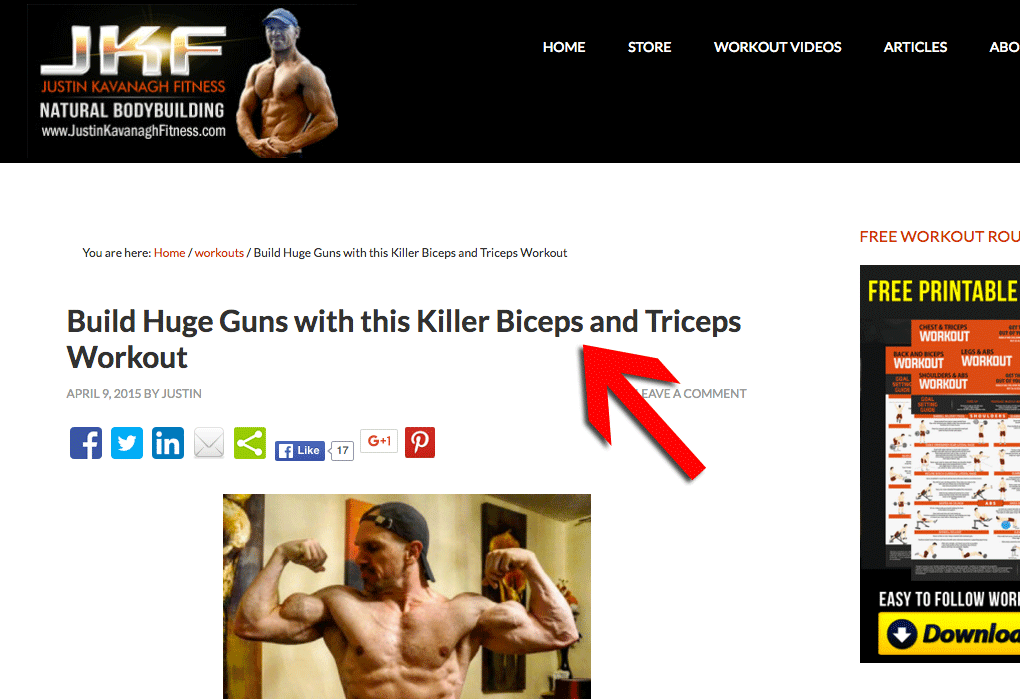
Justin Kavanagh Fitness is helping people build killer biceps and triceps and Google has taken notice!
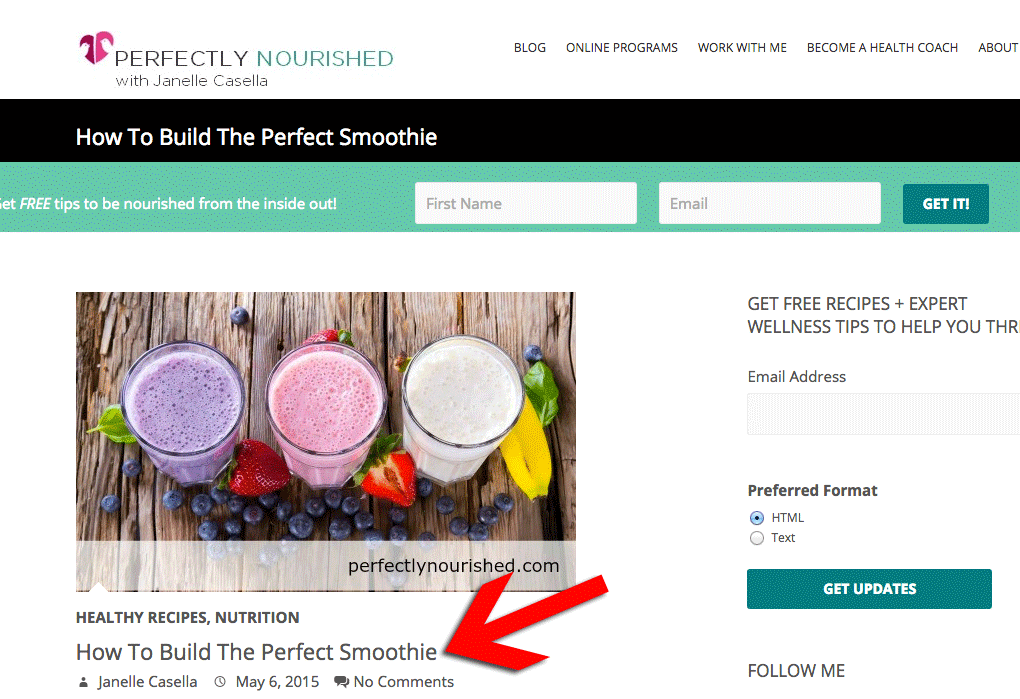
Any guesses what keyword Perfectly Nourished is targeting with this blog post all about perfect smoothie recipes?
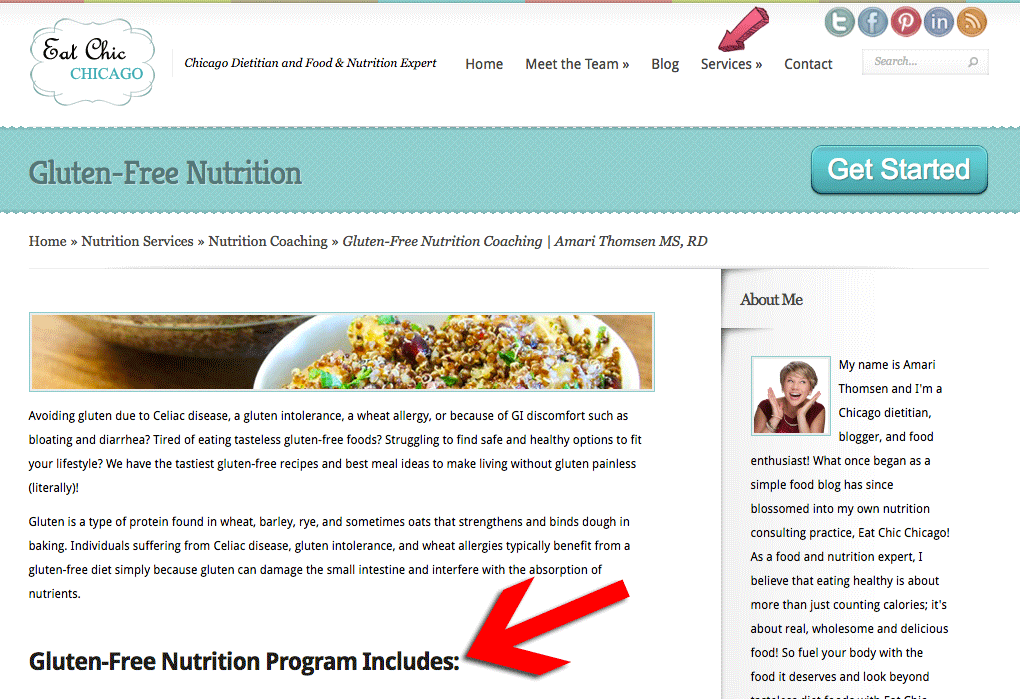
Eat Chic Chicago uses this blog post to attract clients who are looking for gluten-free nutrition coaching.
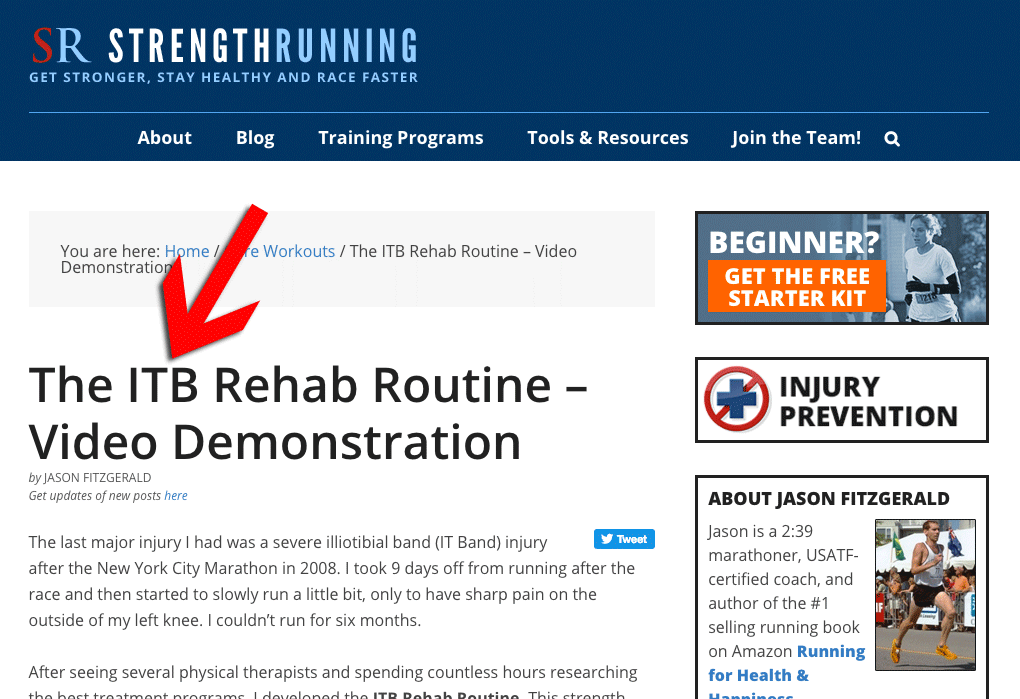
StrengthRunning targets runners who are suffering from ITB syndrome with this extremely helpful blog post.
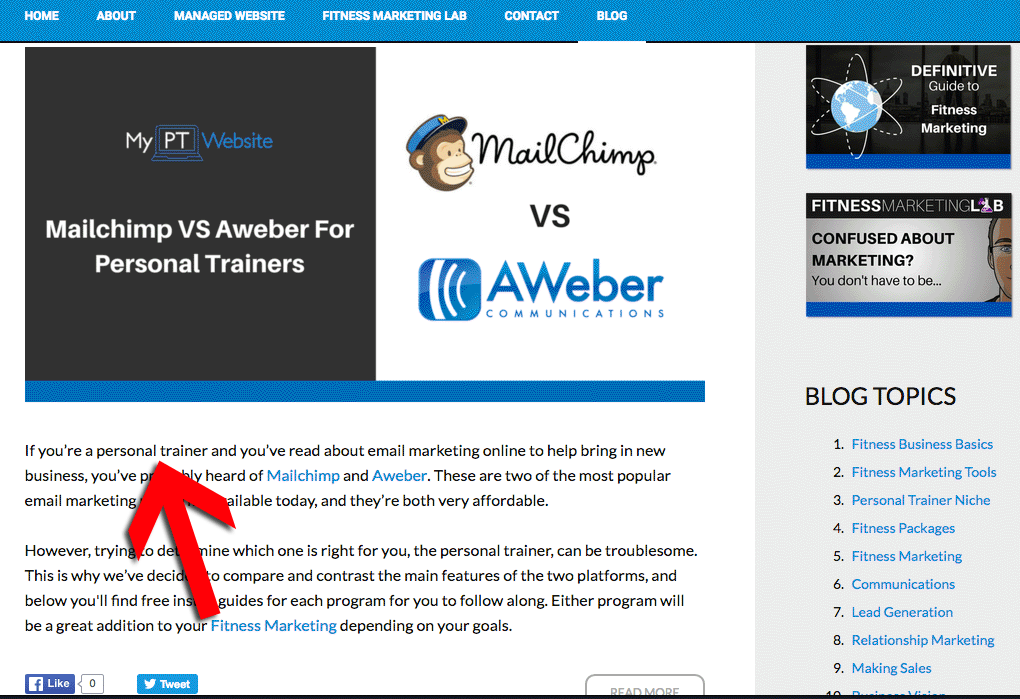
My Personal Training Website loads up its blog posts with keywords that will attract an audience looking for personal trainer website design tips and resources.
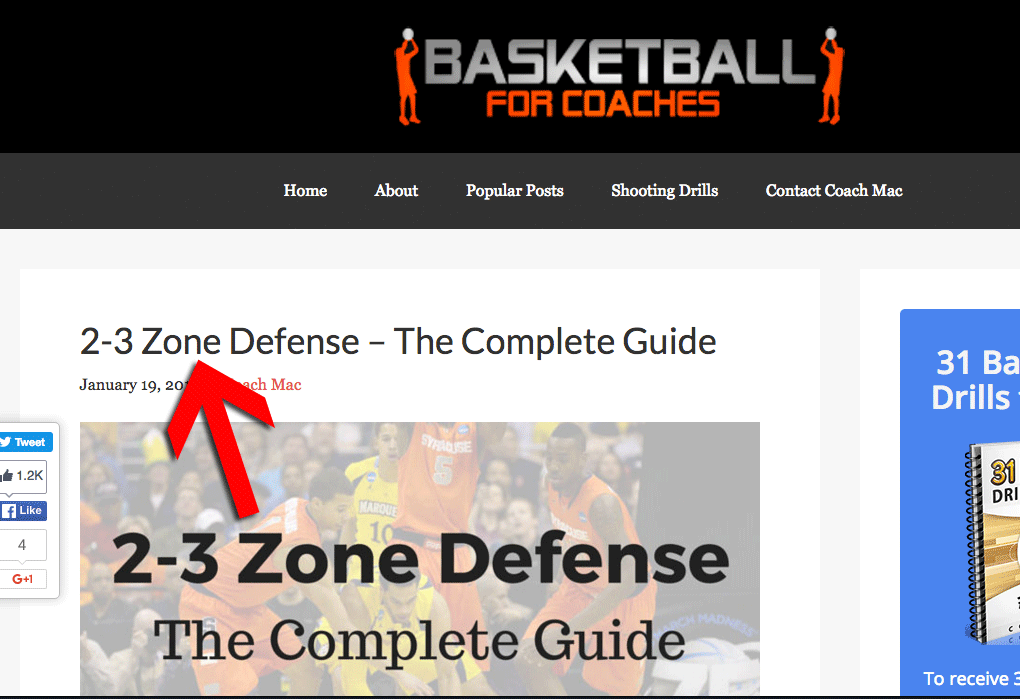
Basketball For Coaches knows that "2-3 Zone Defense" will be a popular search, so they have created perfectly optimized content to nail down that search term.
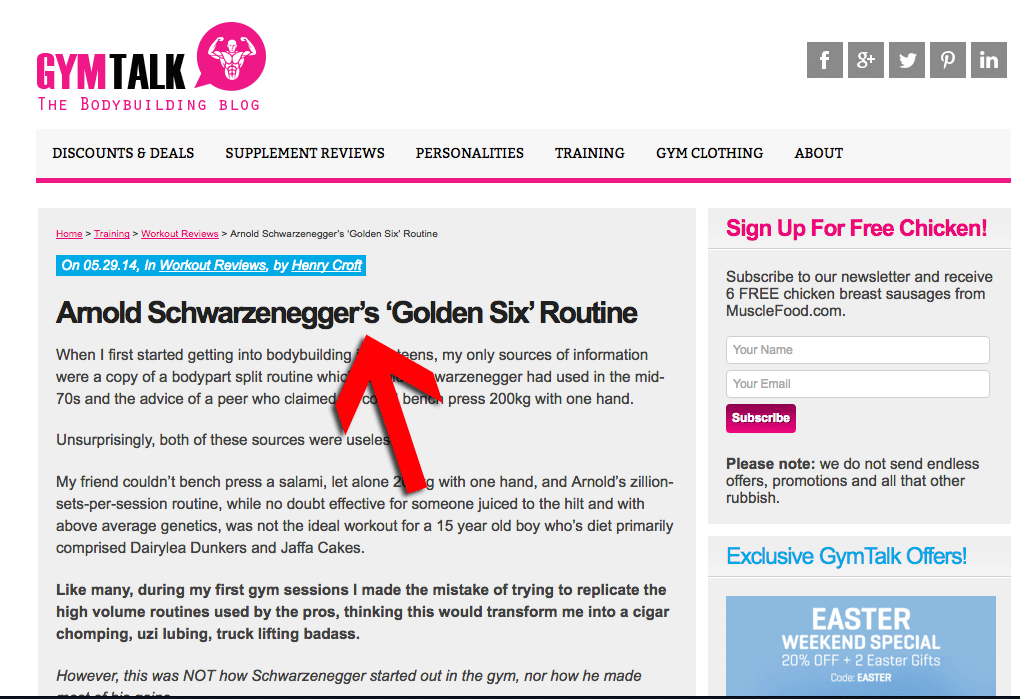
Guys who are looking to bulk up are likely going to be interested in Arnold Schwarzenegger's 'Golden Six" Routine, right?

Katie Widrick is a personal trainer who has broadened her business based on her own personal interests outside of fitness. Anyone need a "stitch fix"?




